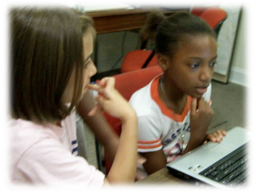Linguistics, Cultural Background, and Comprehension
| Site: | Literacy Solutions On-Demand Courses |
| Course: | Applied Linguistics No. ELL-ED-138 (Non-Facilitated) |
| Book: | Linguistics, Cultural Background, and Comprehension |
| Printed by: | Guest user |
| Date: | Saturday, April 19, 2025, 4:50 AM |
Description
x
1. Linguistic Theory in the Classroom
Social Context and Pragmatics
A first- grade classroom is responsible for a small flower garden on the grounds of the school. As the children prepare to go out to the garden, the teacher asks: Who remembers what the flowers need?
The social context is established by default. The teacher is in charge and most student talk is in  response to teacher questions. This is the structure that is (culturally) expected in classroom settings. The students know from experience that when this kind of question is asked, they are free to call out their responses. The teacher’s question serves two pragmatic functions: focusing the children’s thoughts on what they need to do in the garden, and reviewing plant knowledge learned recently. So the social context and the purpose/ pragmatics have been established.
response to teacher questions. This is the structure that is (culturally) expected in classroom settings. The students know from experience that when this kind of question is asked, they are free to call out their responses. The teacher’s question serves two pragmatic functions: focusing the children’s thoughts on what they need to do in the garden, and reviewing plant knowledge learned recently. So the social context and the purpose/ pragmatics have been established.
How do speech utterances convey meaning? As an English-speaking adult, the teacher is not thinking about these factors, but they affect how the English language learners (and everyone else) understand what she is saying. Meaning is conveyed in all languages by the systematic and coordinated use of rules governing sounds, including intonation, pitch, and juncture (phonology), word formation (morphology), and word order (syntax). Each language in the world uses a finite set of sounds that make a difference for meaning: phonemes. Of course different languages follow different rules, but the components of sounds such as intonation, pitch, and juncture (the relationship between one sound and the sounds that immediately precede and follow it e.g. ice cream and I scream) phonology, word formation (morphology), and word order (syntax) are the rule-governed components of all languages. Each language in the world uses a finite set of sounds that make a difference for meaning: phonemes. For example /p/ and /b/ are phonemes in English because the sound differences make a difference in meaning.
In the classroom conversation referenced above, the children responded to the teacher that they were going to “pull the weeds.” If they had said “pull the seeds,” varying the response by only one phoneme, it would still make sense but would change the meaning completely, in a way that would be disastrous for the garden! If the children had said “pull the grickl,” they would have used a combination of sounds that is not English at all. The correctness of their answer is a function of understanding phonology.
Had the children responded with we will “weeds the pull,” they would have made an error of syntax, that is of English rules of word order or syntax. Alternatively, had they said “pull the weed” instead of “weeds” this would be an issue of morphology because they needed the plural form with the -/s/ suffix to accurately convey meaning. Prefixes, suffixes, and root words are the building blocks or morphemes from which words are formed and, in all languages, the structure of the linguistic building is governed by rules. All three rule-governed systems - phonology, morphology and syntax - work together simultaneously to help create meaningful sentences. Native speakers of any language acquire these structures through imitation and interaction. Polishing sophisticated language production comes with schooling. Second language learners need to acquire (and learn) these linguistic components in a variety of ways during their school experience.
Linguistics and Comprehension
How does all of this work into reading fluency and comprehension? The more we can continue to build the vocabularies of students, the more opportunities we provide them to use words in multiple contexts through reading, writing, listening and speaking, the more likely they are to make academic progress along the continuum of language and literacy development. Before reading comprehension can take place, students must have a vocabulary base to work off of. Before they can use vocabulary, they must know how to deconstruct words - it is a cycle that ebbs and flows to and from a first and second language. These and other linguistics elements (morphology, syntax, phonology, semantics, pragmatics) will be further detailed with regard to second language acquisition in the module that follows.
2. Krashen's Theory of Learning
Krashen’s Theory of Learning
According to Krashen’s (1978) theory of classroom learning, teaching contributes to acquisition only if it provides “comprehensible input” that engages and addresses their interests. The classroom is an especially important place and environment when seeking to optimize instruction for students from literacy- deprived environments. As such, there are a number of influences on language acquisition: age, motivation, comprehensible input, affective conditions, teaching methods and pedagogy. Krashen proposes five hypotheses:
deprived environments. As such, there are a number of influences on language acquisition: age, motivation, comprehensible input, affective conditions, teaching methods and pedagogy. Krashen proposes five hypotheses:
- Acquisition Versus Learning (gradual and natural evolution of learning)
- Natural order (rules are learned from other rules and need not be explicitly taught)
- Monitor (error-correcting mechanisms in the brain)
- Affective Filter (sense of security, safety)
- Input (scaffolding and challenging learners)
The Input hypothesis places learning slightly beyond the learner’s language proficiency, thus pushing the learner further on the language development continuum. This is called the Natural Approach for learning a second language, and below are the recommendations:
- Drill and practice are not as important as natural communication.
- Grammar should not be the center of instruction; acquisition of correct usage will evolve gradually and naturally.
- Scaffold learning to be slightly beyond what the learner can do, yet enough to present success and/or learning by trial-and-error.
- Allow learners to correct their own errors; this will stimulate the most powerful learning experiences. Refrain from correcting them to facilitate this.
- Keep a safe environment for learning without threat (threats distract from learning) where students can safely take risks in an engaging environment.
References
Krashen, S. D. (1978). The monitor model for second language acquisition. In. Ariza, E. N. (2010). What every classroom teacher needs to know about the linguistically, culturally, and ethnically diverse student (2nd ed.). Upper Saddle River, NJ: Pearson Education, Inc.
3. Language Used for Social Interaction Versus Language Used for Academic Learning

Understanding Social Language and Academic Language
There is a distinction between language used for basic social interaction, and language used for academic purposes.
- Basic Interpersonal Communication Skills (BICS) are language skills needed for social conversation purposes, that is they can speak English well enough to interact with their peers, talk on the telephone, and negotiate meanings with adults.
- Cognitive Academic Language Proficiency (CALP) refers to formal language skills, including listening, speaking, reading, and writing, used for academic learning. Cognitive Academic Language Proficiency refers to the ability to demonstrate academic competence in the new language orally and in writing at a level commensurate with that of their native-speaking peers. For students with no prior schooling and no primary language support (i.e. neither the student nor members of their family have attended school in their native language) may take as much as seven to ten years to acquire academic skills in their new language. (Thomas & Collier, 2002). In other words, newcomers may need substantial time and educational support to develop English skills necessary for success in school.
In addition to mastery of academic English language terms and sentence constructs, academic language use, whether oral or written, requires a growing reservoir of background knowledge pertinent to any given discipline, along with knowledge of the conventions and structures of oral and written English.
Equally important for students new to English is explicit instruction in socially and culturally appropriate ways of using English, oral and written. At the primary levels, socialization of children into the conventions of sharing, saying “please” and “thank you” is a normal part of the curriculum. At the upper grade levels, teachers assume that these culturally appropriate speech patterns and behaviors have already been learned. It is frequently assumed that the rules of classroom behavior such as taking turns, talking, listening, and responding to other students and the teacher in appropriate ways have also been learned in the earlier grades. None of these social/cultural conventions can be taken for granted with respect to the English Language learner.
Many teachers and stakeholders make the often logical mistake of placing ELLs into more advanced classes before they are ready. Because they may have a good foundation and making good progress in social language, and the younger they are the more native-like they may sound), it is easily perceived that the students may know more English than they actually do. Although learners might be accomplished speakers and sound native-like, academically they might be years behind native speakers. this lag may be explained by weak or interrupted schooling in the home country, or by months of non-comprehensible academic instruction delivered in English, or a combination of both (Freeman, Freeman, & Mercuri, 2002).
Cummins (1981, 1982) analyzed the standardized test scores of ELLs and compared them to native English speakers. He found that, while the ELLS could acquire a social language rapidly, generally within two years, it took five to seven to acquire academic language. Compound this with a child who speaks with no foreign accent, they can be easily confused as proficient. When a student has strong academic knowledge in a first language, it can be transferred to the second language. When a student has a strong foundation in a native language, ti is assumed that the transfer to the second is more a question of language than of knowledge learning. Thus it is understandable that a child who learns to read in his or her native language first, regardless of the native language, understands the concept of reading. Therefore in ELLl reading class, the concept of deciphering print is already understood; only the new language must be learned. Cummin's idea of Common Underlying Proficiency explains why an international high school student with strong academic background from the native country might fare better academically in an American school than in a second language learner who was brought up in the United States.
The time required for students to acquire social language is up to two years, and academic language five to ten years - this is a great difference, and it pcan have a profound effect on academic achievement (Cummins, 1981a, 1982). Students arriving in the United States with limited or interrupted education will have a much more difficult time catching up to their English-speaking peers academically.
4. Classroom Practice Implications of Second Language Acquisition Theory
With the demise of Behaviorism as a theory undergirding classroom practice, particularly in the teaching of English as a Second Language, educators are wise to focus on the following:
- The ability of the student to comprehend what is said, and to respond to what is said or asked without necessarily understanding all the words.
- The ability of the student to make him/herself understood, even if ungrammatically.
- The negotiations that develop linguistic competence and confidence through interactions with native-English speakers (teachers and fellow students).
The strategies that have been shown to be most effective in the classroom include:
- Differentiated instruction that offers a variety of word contexts, chunked text (short readings), and rewritten text appropriate for the students' stage of language development.
- Scaffolding of content through the use of graphic organizers and tiering tasks into manageable chunks.
- Use of group work through the form of peer review, editing centers, writing centers, literacy circles, and collaborative groups with roles.
Grade level/classroom organization needs to allow all English Language Learners to develop the content knowledge necessary for academic English proficiency, as well as the vocabulary that accompanies it and the grammar of English sentence construction. This means a combination of inclusion classrooms which encourage interaction-based (negotiated) learning, and sheltered English instruction, whether focused on basic acquisition of English, or on the development of content knowledge.
SDAIE and SIOP
Categorically referred to SDAIE (Specially Designed Academic Instruction in English), SIOP (Sheltered Instruction Observation Protocol) is the most thoroughly researched version of SDAIE and has been shown to be highly effective in bringing English Language Learners to academic proficiency.
To insure Comprehensible Input consistent with Innatist Theory, teaching and speaking devices such as paraphrasing, repetition of key points, reference to concrete materials, and acting out of meanings are some of the ways teachers can provide comprehensible input while conveying meaning to English Language Learners. By pairing verbal and nonverbal channels of communication words and meanings become more accessible, and also form the basis for the learner to construct the new language system for herself. For example, when a maps, globes, and photographs are used in a geography or social studies lesson, the student has more opportunities to take in and to express the new knowledge. Similarly the use of diagrams and charts in biology lessons, astronomy, or other science lessons creates additional avenues for learning.
Error correction can be carried out in a sensitive and natural way. It is important to keep in mind that there is a natural progression of mastering the grammatical intricacies and ELLs in the early stages of learning will make grammatical errors that do not affect understanding. There is no reason, at that stage, to correct those errors. Vocabulary errors which interfere with comprehension are important because it is through mastery of new verbs and nouns that students improve their comprehension of English conversation and instruction, as well as their ability to express themselves clearly.
For example in a third-grade English language development classroom, the children are playing a board game with the teacher standing nearby. One of the children, a beginning in English says, “I putting the marker on the points.” The teacher does not try to correct the pronoun or verb usage because it does not interfere with comprehension. She might tell the children that “those are called ‘dots’; you are putting the marker on the dots”.
As a useful guide, error correction for beginning English learners, needs to focus on those words which affect comprehension. These are more likely to be remembered and many of the grammatical issues will sort themselves out as the learner gains self-confidence and engages in more frequent communication activities.
Cultural Competence can be taught through role-playing as a way to help students learn both the language and behaviors appropriate to specific social situations. These can include meeting new friends at a party, using the telephone, applying for a job (older students), going to the doctor, and most important, asking the teacher for assistance. Even ways of expressing emotions such as sympathy, gratitude, and enthusiasm are all part of developing communicative (cultural) competence in English.
Scaffolding is about making instruction appropriate, within the students’ grasp, and meaningfully engaging. Use of cognates is another way to acclimate second language learners to the English language as they draw as much meaning from context as possible. Provide students with a list of common cognates for reference. Teachers can also point them out explicitly in every day speech, or as opportunities arise within the context of instruction.
Explicit vocabulary instruction is probably the best way we can accelerate students’ academic achievement overall, especially for ELLs. While the push of the Common Core, and many state standards that have aligned to the Common Core, is for learning in context (looking at words within words, whole sentences and paragraphs to unlock new/unknown word meanings), ELL students need focused and explicit vocabulary instruction, especially prior to reading text. Tiered Questions
Using tiered questions, or questions scaffolded by complexity (intentionally) can keep ELL students engaged as more questions are asked the build upon the former. Tiering questions is a way to achieve this. Building them into lessons by differentiating them, for example grouping students and holding them responsible for answers according to their groups. Asking questions throughout each lesson allows them to practice their thinking ahead of time, while better preparing them for assessments when they must think on their own. Tailor questions for each stage of language accordingly.
Example of Tiered Questions: Early Production: yes/no, followed by short phrases. Ask students to point to pictures, books, or objects around the room to depict response and understanding. Speech Emergence: ask questions for short response, such as short constructed response or short answer questions. A one-word response at this phase is no longer appropriate. Why and how questions are appropriate.
Intermediate and Advanced Fluency: Hold students accountable at this stage for longer and more elaborate answers in any setting: whole class, peer-to-peer, student-to-teacher, small group. What might have happened if? And, “Why did you think that?” Are good questions to ask at this stage. Advanced Fluency: Students can retell stories, events, story elements, main ideas, and even make inferences. There continues to be evidence of increased educational attainment when English fluency increases among bilingual and ELL students, particularly when differentiation is used to scaffold and increase achievement (Strand and Demie, 2005; Demie and Strand, 2006; Tomlinson, 2008).